The Fixing Agent Market is estimated to be valued at USD 3.7 billion in 2025 and is projected to reach USD 6.1 billion by 2035, registering a compound annual growth rate (CAGR) of 5.3% over the forecast period.
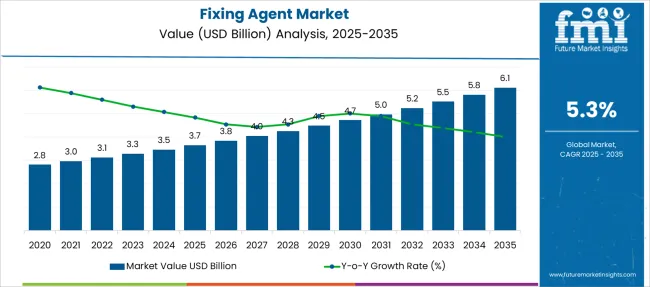
| Metric | Value |
|---|---|
| Fixing Agent Market Estimated Value in (2025 E) | USD 3.7 billion |
| Fixing Agent Market Forecast Value in (2035 F) | USD 6.1 billion |
| Forecast CAGR (2025 to 2035) | 5.3% |
The fixing agent market is witnessing steady expansion driven by growing demand in the textile and paper industries for improving dye fixation and enhancing product quality. Industry trends highlight the increasing importance of efficient and eco-friendly fixation technologies to reduce chemical consumption and environmental impact.
The rising focus on sustainable manufacturing practices has encouraged the adoption of advanced fixing agents that improve color fastness and fabric durability. Technological developments have led to the introduction of new product forms that are easier to handle and apply, increasing process efficiency.
Additionally, stringent environmental regulations have driven manufacturers to innovate formulations that minimize water usage and chemical waste. The market outlook remains positive as industries continue to seek reliable fixing agents that balance performance with sustainability. Segmental growth is expected to be led by the solid product form due to its ease of storage and application, and the cationic fixing agent product type for its superior dye affinity and effectiveness.
The market is segmented by Product Form and Product Type and region. By Product Form, the market is divided into Solid and Liquid. In terms of Product Type, the market is classified into Cationic Fixing Agent, Cetylpyridinium Chloride, Cetylpyridinium Bromide, Polyamine Contraction, Crosslinking Fixing Agent, Anionic Fixing Agent, Zinc Salt, Acetic Acid, Acetone, and Other Product Types. Regionally, the market is classified into North America, Latin America, Western Europe, Eastern Europe, Balkan & Baltic Countries, Russia & Belarus, Central Asia, East Asia, South Asia & Pacific, and the Middle East & Africa.
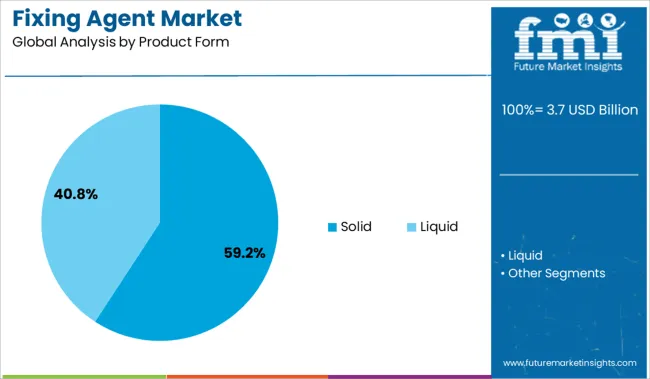
The solid product form segment is expected to capture 59.2% of the fixing agent market revenue in 2025, maintaining its dominance. Growth in this segment is driven by the convenience and stability solid fixing agents offer during transportation, storage, and handling.
The solid form allows precise dosing and reduces the risk of spillage or degradation compared to liquid alternatives. Industrial users appreciate the extended shelf life and ease of integration into existing dyeing processes.
Moreover, solid fixing agents typically require less packaging material, aligning with environmental sustainability goals. The solid format has been favored in large-scale production settings where batch consistency and operational efficiency are priorities. As industries continue to optimize their processes, the solid product form is expected to remain the preferred choice.
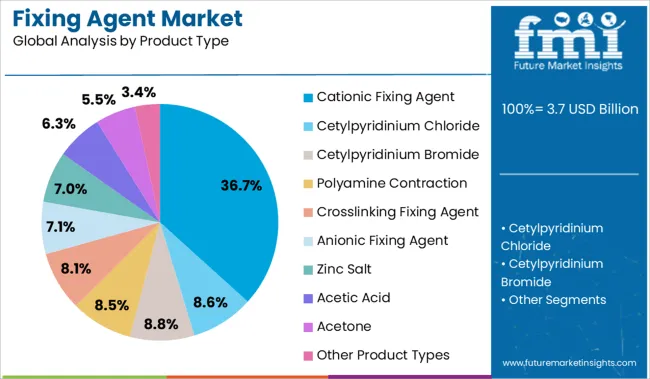
The cationic fixing agent segment is projected to contribute 36.7% of the market revenue in 2025, establishing itself as a leading product type. This growth is largely attributed to the cationic agents’ strong affinity for negatively charged dye molecules, resulting in enhanced fixation rates and improved color fastness.
Cationic fixing agents have been widely adopted in cotton and blended fabric dyeing, where their performance in reducing dye bleeding and improving wash durability is critical. Advances in formulation have further improved the environmental profile of these agents by reducing chemical load and wastewater toxicity.
Textile manufacturers prioritize cationic fixing agents for their ability to deliver consistent and vibrant colors while complying with evolving environmental standards. As demand for high-quality and sustainable textiles grows, the cationic fixing agent segment is expected to maintain its prominent position in the market.
Sales of fixing agent are increasing, as it is a vital ingredient in dyeing applications, according to the printing industry. As a result, by the end of the forecast period, customers who are increasingly interested in high-quality printed clothes are expected to have a favorable impact on the global fixing agent market growth.
For example, worldwide garment consumption was expected to be USD 1.8 trillion in 2020, accounting for about 2% of global GDP of USD 79.3 trillion. The sales of global fixing agent, on the other hand, are being hampered by rising raw material prices.
Furthermore, the food and beverage industry's demand for fixing agent will be hampered by the strict requirements related to product food applications.
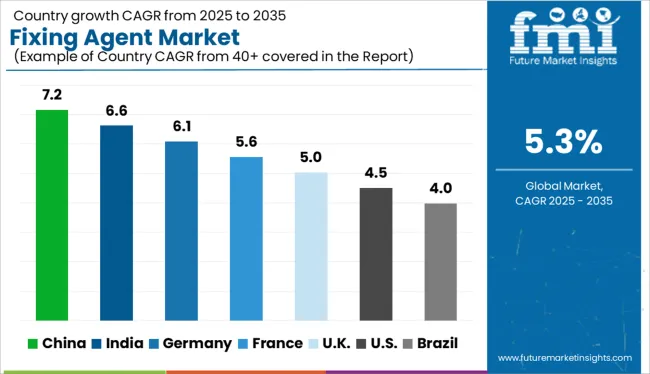
Geographically, the fixing agent market outlook is influenced by each region's textile and dye industries. The Asia Pacific region, excluding Japan, is anticipated to account for one-fourth of the global fixing agent market size.
Factors contributing to the sales of fixing agent in the APEJ region include economies with large populations and extensive industrial infrastructure, such as China and India. As a result, the Asia Pacific fixing agent market is expected to grow at a rapid pace throughout the forecast period.
In terms of fixing agent market volume share, Europe and North America are expected to grab half of the market during the forecast period, followed by Asia Pacific. Over the projected period, activities such as refinery repairs, textile industry enhancements, and capacity restarts in the GCC nations of the Middle East and Africa are expected to depress demand for fixing agent.
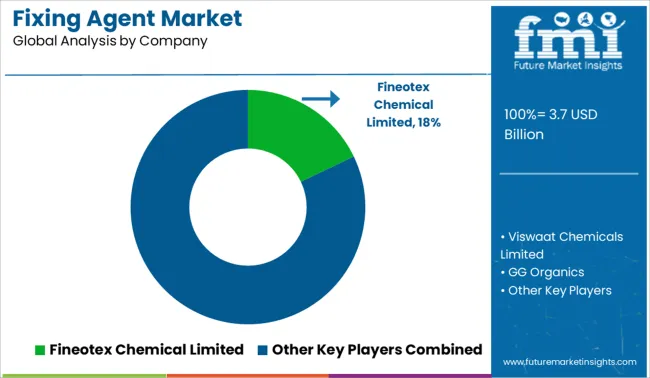
Few global fixing agent key players are Fineotex Chemical Limited, Viswaat Chemicals Limited, GG Organics, Protex Korea, CHT Group, eksoy Chemicals, HT Fine Chemical Co., Ltd., SENKA Corporation, PROTEX, D. K. CORPORATION, Piedmont Chemical Industries, NICCA Chemical, Avocet Dye & Chemical, S D International, Jain Chem, Vertellus Holdings, Achitex Minerva Spa, and among others.
To solidify their market position and increase sales of fire retardant coatings, these companies are utilizing various strategies, such as mergers and acquisitions, partnerships, collaborations, to cope up with the sales of fixing agent.
| Report Attribute | Details |
|---|---|
| Growth Rate | CAGR of 5.3% from 2025 to 2035 |
| Base Year for Estimation | 2024 |
| Historical Data | 2020 to 2024 |
| Forecast Period | 2025 to 2035 |
| Quantitative Units | Revenue in USD Million, Volume in Kilotons and CAGR from 2025 to 2035 |
| Report Coverage | Revenue Forecast, Volume Forecast, Company Ranking, Competitive Landscape, Growth Factors, Trends and Pricing Analysis |
| Segments Covered | Application, Product Type, Product form, Region |
| Regions Covered | North America; Latin America; Europe; South Asia; East Asia; Oceania; Middle East and Africa |
| Key Countries Profiled | USA, Canada, Brazil, Argentina, Germany, UK, France, Spain, Italy, Nordics, BENELUX, Australia & New Zealand, China, India, ASEAN, GCC, South Africa |
| Key Companies Profiled | Fineotex Chemical Limited; Viswaat Chemicals Limited; GG Organics, Protex Korea; CHT Group; eksoy Chemicals; HT Fine Chemical Co., Ltd.; SENKA Corporation; PROTEX; D. K. CORPORATION; Piedmont Chemical Industries; NICCA Chemical; Avocet Dye & Chemical; S D International; Jain Chem; Vertellus Holdings; Achitex Minerva Spa |
| Customization | Available Upon Request |
The global fixing agent market is estimated to be valued at USD 3.7 billion in 2025.
The market size for the fixing agent market is projected to reach USD 6.1 billion by 2035.
The fixing agent market is expected to grow at a 5.3% CAGR between 2025 and 2035.
The key product types in fixing agent market are solid and liquid.
In terms of product type, cationic fixing agent segment to command 36.7% share in the fixing agent market in 2025.






Full Research Suite comprises of:
Market outlook & trends analysis
Interviews & case studies
Strategic recommendations
Vendor profiles & capabilities analysis
5-year forecasts
8 regions and 60+ country-level data splits
Market segment data splits
12 months of continuous data updates
DELIVERED AS:
PDF EXCEL ONLINE
Food and Beverages Color Fixing Agents Market Analysis by Product Type, Application and Region through 2035
AI-Driven Agent-Based Modeling – Predictive Insights & Analysis
Reagent Bottle Market Growth & Industry Forecast 2025 to 2035
Reagent Filling Systems Market Analysis – Growth & Forecast 2024-2034
Wetting Agent Market Size and Share Forecast Outlook 2025 to 2035
Matting Agents Market Size and Share Forecast Outlook 2025 to 2035
Healing Agents Market (Skin Repair & Soothing Actives) Market Size and Share Forecast Outlook 2025 to 2035
Foaming Agents Market Size and Share Forecast Outlook 2025 to 2035
Firming Agents Botox-Like Market Size and Share Forecast Outlook 2025 to 2035
Sealing Agent for Gold Market Size and Share Forecast Outlook 2025 to 2035
Heating Agents Market Size and Share Forecast Outlook 2025 to 2035
Cooling Agents Market Size and Share Forecast Outlook 2025 to 2035
Firming Agents Market Growth – Product Innovations & Applications from 2025 to 2035
Release Agent Market – Trends & Forecast 2025 to 2035
Gelling Agent Market Insights – Texture & Food Innovation 2025 to 2035
Raising Agents Market Trends – Growth & Industry Forecast 2024 to 2034
Weighing Agents Market Size and Share Forecast Outlook 2025 to 2035
Draining Agents Market Size and Share Forecast Outlook 2025 to 2035
Flatting Agents Market Size and Share Forecast Outlook 2025 to 2035
Proptech Agent Tool Market Trends - Growth & Forecast 2025 to 2035

Thank you!
You will receive an email from our Business Development Manager. Please be sure to check your SPAM/JUNK folder too.
Chat With
MaRIA